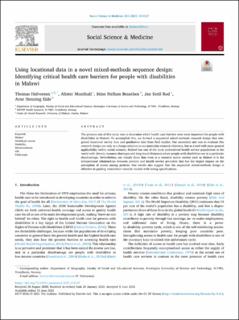| dc.contributor.author | Halvorsen, Thomas | |
| dc.contributor.author | Munthali, Alister | |
| dc.contributor.author | Braathen, Stine Hellum | |
| dc.contributor.author | Rød, Jan Ketil | |
| dc.contributor.author | Eide, Arne Henning | |
| dc.date.accessioned | 2022-03-04T09:05:43Z | |
| dc.date.available | 2022-03-04T09:05:43Z | |
| dc.date.created | 2021-07-22T14:07:24Z | |
| dc.date.issued | 2021 | |
| dc.identifier.citation | Social Science and Medicine. 2021, 283 1-10. | en_US |
| dc.identifier.issn | 0277-9536 | |
| dc.identifier.uri | https://hdl.handle.net/11250/2983011 | |
| dc.description.abstract | The primary aim of this study was to determine which health care barriers were most important for people with disabilities in Malawi. To accomplish this, we devised a sequential mixed-methods research design that integrated locational survey data and qualitative data from field studies. Our secondary aim was to evaluate this research design not only as a design-solution to our particular research objective, but as a tool with more general applicability within social sciences. Malawi has one of the most underserved health service populations in the world with chronic resource shortages and long travel distances where people with disabilities are at a particular disadvantage. Nevertheless, our results show that even in a resource scarce society such as Malawi it is the interpersonal relationships between patients and health service providers that has the largest impact on the perception of access among patients. Our results also suggest that the sequential mixed-methods design is effective in guiding researchers towards models with strong specifications. | en_US |
| dc.language.iso | eng | en_US |
| dc.publisher | Elsevier | en_US |
| dc.rights | Navngivelse 4.0 Internasjonal | * |
| dc.rights.uri | http://creativecommons.org/licenses/by/4.0/deed.no | * |
| dc.title | Using locational data in a novel mixed-methods sequence design: Identifying critical health care barriers for people with disabilities in Malawi | en_US |
| dc.type | Journal article | en_US |
| dc.type | Peer reviewed | en_US |
| dc.description.version | publishedVersion | en_US |
| dc.source.pagenumber | 1-10 | en_US |
| dc.source.volume | 283 | en_US |
| dc.source.journal | Social Science and Medicine | en_US |
| dc.identifier.doi | 10.1016/j.socscimed.2021.114127 | |
| dc.identifier.cristin | 1922428 | |
| cristin.ispublished | true | |
| cristin.fulltext | original | |
| cristin.qualitycode | 2 | |

